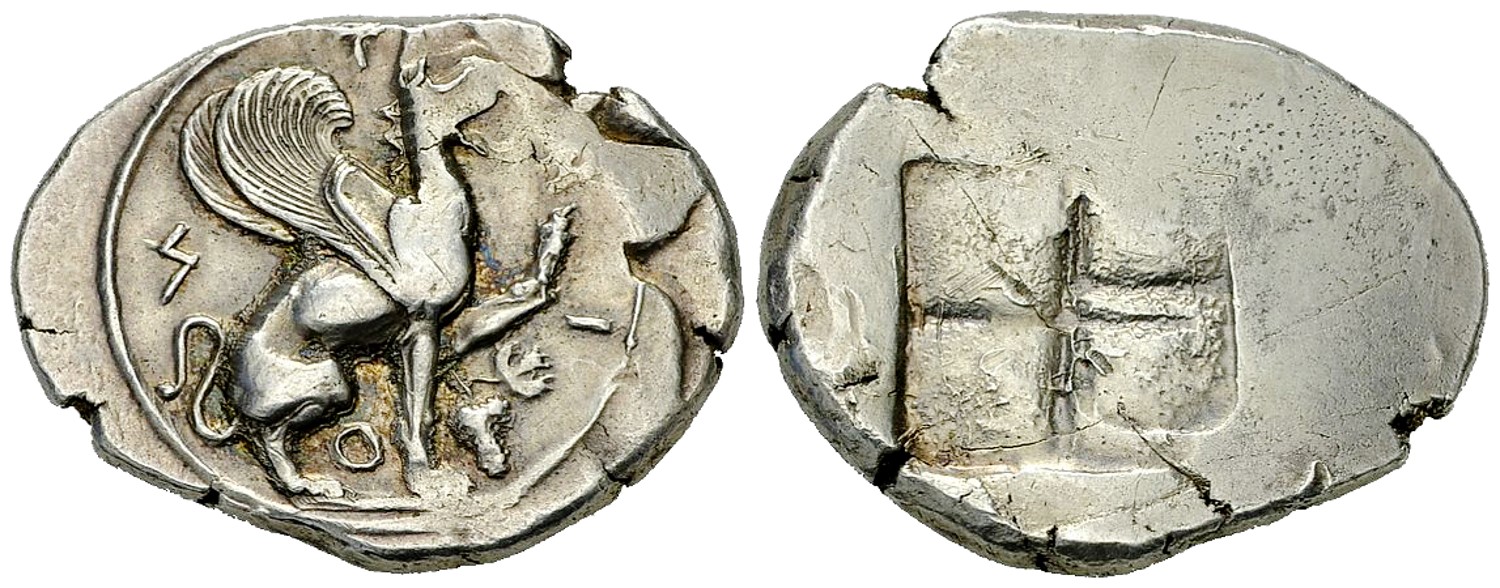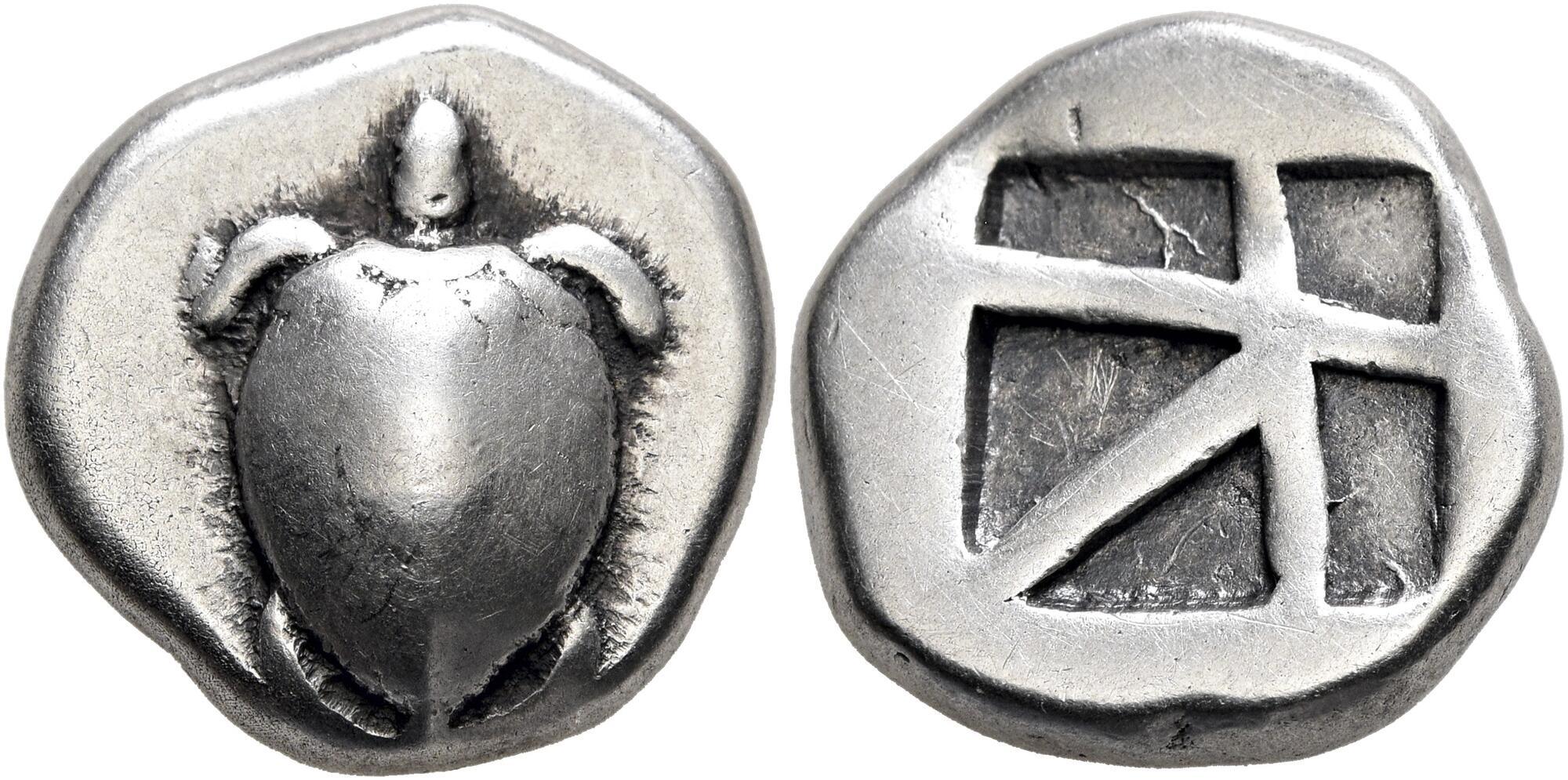2542 - Teos (stater griffin/incuse square) over Aegina (turtle/incuse square) (Auctiones, EA 50, Sept. 2013, 73)
From SILVER
478 BCE - 465 BCETHION
Images
Overstriking coin

Teos_on_Aegina_Auctiones, _EA_50, _11_Sept._2013, _73.jpg [1]
Location/history
| Sale(s)Sale(s) ᵖ: | Auctiones, EA 50, 11 Sept. 2013, 73 = Auctiones, EA 50, 11 Sept. 2016, 73 | |
Overstriking coin
Description
| ObverseInscription or printing placed on the obverse.: | THION (Greek) Griffin seated right, a forepaw raised. To lower right, bunch of grapes with leaf. | ReverseInscription or printing placed on the reverse.: | Quadripartite incuse square |
Mint and issuing power
| MintIdentifies the place of manufacture or issue of a numismatic object.: | Teos | Ancient regionAncient region. | Ionia | Modern countryModern country: Turkey | AuthorityIdentifies the issuing power. The authority can be "pretended" when the name or the portrait of X is on the coin but he/she was not the issuing power. It can also be "uncertain" when there is no mention of X on the coin but he/she was the issuing power according to the historical sources: |
Chronology
| FromIdentifies the initial date in a range assigned in a numismatic context. 478 BCE toIdentifies the final date in a range assigned in a numismatic context.. 465 BCE | Classical 480-323 BC |
Physical description
| MetalThe physical material (usually metal) from which an object is made.: Silver |
WeightWeight of the numismatic object (in grams). in grams: 11.9411.94 g <br />11,940 mg <br /> | DenominationTerm indicating the value of a numismatic object. Examples: tetradrachm, chalkous, denarius.: stater |
|
| DiameterDescribes diameter of an object (in mm).: 2828 mm <br />2.8 cm <br /> | |||
References
| Coin referenceReference of the Coin: | Coin series referenceReference to coin series study: | Balcer 19681Balcer 1968, MacDonald 1994a2MacDonald 1994a, MacDonald 19953MacDonald 1995, n° 5, pl. 50, n° 3, MacDonald 20094MacDonald 2009, n° 124 | |
| Coin series web referenceCoin series web references: | |||
Overstruck type
Description
| ObverseInscription or printing placed on the obverse.: | Turtle (visible on obverse) | ReverseInscription or printing placed on the reverse.: | Incuse square (visible on reverse) |
Mint and issuing power
| MintIdentifies the place of manufacture or issue of a numismatic object. ᵖ: | Aegina | Ancient regionAncient region. ᵖ | Aegina | Modern countryModern country: Greece | AuthorityIdentifies the authority in whose name (explicitly or implicitly) a numismatic object was issued. ᵖ: |
Chronology
| FromIdentifies the initial date in a range assigned in a numismatic context. 475 BCE toIdentifies the final date in a range assigned in a numismatic context.. 450 BCE | Classical 480-323 BC |
Physical description
| DenominationTerm indicating the value of a numismatic object. Examples: tetradrachm, chalkous, denarius. ᵖ: | stater |
StandardStandard. ᵖ: | Aeginetic |
References
| Coin type referenceReference to coin series study ᵖ: | HGC 65HGC 6, n° 429, Meadows (forthcoming)6Meadows (forthcoming), Groups IIa-IIb | ||
| Coin series web reference overstruckCoin series web references overstruck: | |||
Additional data
| Frequency of overstrikesFrequency of overstrikes: | frequent | Level of confidenceLevel of confidence of the identification: | sure |
| RemarksRemarks: | Teos over very flattened Aigina. Turtle head visible about 2:00 flipper from 3:00 to 4:00 (DMD) | ||
References
- ^ Balcer, Jack M. (1968), "The early silver coinage of Teos", Revue Suisse de Numismatique 47, p. 5-50.
- ^ MacDonald, David (1994), "A Teos/Abdera overstrike", Schweizerische Münzblätter, 44 (174), p. 37-40.
- ^ McDonald, David (1995), "A note on CH VIII No. 47: Ionia 1983", Numismatic Chronicle 155, p. 321-323, pl. 50, n° 3.
- ^ Macdonald, David (2009), Overstruck Greek coins: studies in Greek chronology and monetary theory, Whitman Publishing, Atlanta.
- ^ Hoover, Oliver D. (2010), The Handbook of Greek Coinage Series, volume 6 : handbook of coins of the islands: Adriatic, Iionian, Thracian, Aegean, and Carpathian seas (excluding Crete and Cyprus), sixth to first centuries BC, Lancaster, 358 p.
- ^ Meadows, Andrew (forthcoming), Greek coinage in the Persian Empire: The Malayer 1934 Hoard (IGCH 1790).
